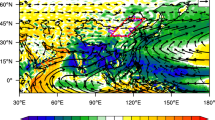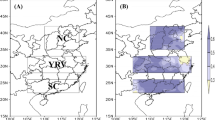Abstract
This paper discusses the interannual variation of winter cold surges (CSs) over East Asia (EA) from the perspective of the cold air path and its relationship with autumn Barents Sea ice concentration (BSIC). Flexible particle dispersion model for large-scale atmospheric transport process simulation is used to track the cold air path of 301 CSs in EA in winters from 1979 to 2017, and the probability density distribution of cold air path is calculated by kernel density estimation. The cold air mainly originates from the Ural Mountains, and is continuously cooled by the impact of cold land, then accumulates and strengthens near the Lake Baikal, and finally invades EA under the guidance of the northwest airflow. The autumn BSIC has a significant negative correlation with CSs over EA. The decreased autumn BSIC hinders the spread of zonal warm advection over Eurasia and makes the soil temperature near Lake Baikal drop, and the negative anomaly of soil temperature persists from autumn to winter, strengthening cold source therein, which provides suitable thermal conditions for occurring more CSs over EA. Moreover, the decreased autumn BSIC can also persist to winter, which leads to the positive anomaly of the geopotential height over the polar region. Through the propagation of Rossby wave, the negative geopotential height anomaly over EA is excited and provides the appropriate dynamic conditions for forming more CSs in EA. The simulations from the Community Atmosphere Model version 5.3 (CAM5.3) further confirm the proposed possible mechanism.










Similar content being viewed by others
Availability of data and material
All data used in this paper is open. The citations of the data are listed in Section 2.1.
Code availability
The FLEXPART model used in this paper to track CS paths is obtained from https://www.flexpart.eu/.
References
Chan J, Li C (2004) The East Asia winter monsoon. East Asian Monsoon, C.-P. Chang, Ed., World Scientific 54–106
Cohen J, Zhang X, Francis J, Jung T, Kwok R, Overland J, Ballinger TJ, Bhatt US, Chen HW, Coumou D, Feldstein S, Gu H, Handorf D, Henderson G, Ionita M, Kretschmer M, Laliberte F, Lee S, Linderholm HW, Maslowski W, Peings Y, Pfeiffer K, Rigor I, Semmler T, Stroeve J, Taylor PC, Vavrus S, Vihma T, Wang S, Wendisch M, Wu Y, Yoon J (2020) Divergent consensuses on Arctic amplification influence on midlatitude severe winter weather. Nat Clim Chang 10:20–29. https://doi.org/10.1038/s41558-019-0662-y
Compo G, Kiladis G, Webster P (1999) The horizontal and vertical structure of East Asian winter monsoon pressure surges. Q J R Meteorol Soc 125:29–54. https://doi.org/10.1002/qj.49712555304
Dai H, Fan K, Liu J (2019) Month-to-month variability of winter temperature over northeast China linked to sea ice over the Davis Strait–Baffin Bay and the Barents–Kara Sea. J Clim 32:6365–6384. https://doi.org/10.1175/JCLI-D-18-0804.1
Dee D et al (2011) The ERA-interim reanalysis: configuration and performance of the data assimilation system. Q J R Meteorol Soc 137:553–597. https://doi.org/10.1002/qj.828
Ding Y (1990) Build-up, air mass transformation and propagation of Siberian high and its relations to cold surge in East Asia. Meteorl Atmos Phys 44:281–292. https://doi.org/10.1007/BF01026822
Ding Y, Krishnamurti T (1987) Heat budget of the Siberian high and the winter monsoon. Mon Weather Rev 115:2428–2449. https://doi.org/10.1175/1520-0493(1987)115<2428:HBOTSH>2.0.CO;2
Fan K, Xie Z, Wang H, Xu Z, Liu J (2018) Frequency of spring dust weather in North China linked to sea ice variability in the Barents Sea. Climate Dynamics 51(11-12):4439–4450
Fereday D, Maidens A, Arribas A, Scaife A, Knight J (2012) Seasonal forecasts of northern hemisphere winter 2009/10. Environ Res Lett 7:034031. https://doi.org/10.1088/1748-9326/7/3/034031
Francis J (2015) The Arctic matters: extreme weather responds to diminished Arctic sea ice. Environ Res Lett 10:091002. https://doi.org/10.1088/1748-9326/10/9/091002
Gu L, Hanson P, Post W, Kaiser D, Yang B, Nemani R, Pallardy S, Meyers T (2008) The 2007 eastern U.S. spring freezes: increased cold damage in a warming world? BioScience 58:253–262. https://doi.org/10.1641/B580311
Hu Z, Zhang C, Hu Q, Tian H (2014) Temperature changes in central Asia from 1979 to 2011 based on multiple datasets. J Clim 27:1143–1167. https://doi.org/10.1175/JCLI-D-13-00064.1
Inoue J, Hori M, Takaya K (2012) The role of Barents sea ice in the wintertime cyclone track and emergence of a warm-Arctic cold-Siberian anomaly. J Clim 25:2561–2568. https://doi.org/10.1175/JCLI-D-11-00449.1
Inouye D (2000) The ecological and evolutionary significance of frost in the context of climate change. Ecol Lett 3:457–463. https://doi.org/10.1046/j.1461-0248.2000.00165.x
IPCC (2013) The physical sciences basis. Contribution of working group I to the fifth assessment report of the intergovernmental panel on climate change. Cambridge University Press, Cambridge, p 1535
Jeong J, Ho C (2005) Changes in occurrence of cold surges over East Asia in associated with Arctic Oscillation. Geophys Res Lett 32:L14704. https://doi.org/10.1029/2005GL023024
Ji L, Fan K (2019) Interannual linkage between wintertime sea-ice cover variability over the Barents Sea and springtime vegetation over Eurasia. Clim Dyn 53:5637–5652. https://doi.org/10.1007/s00382-019-04884-0
Kim B, Son S, Min S et al (2014) Weakening of the stratospheric polar vortex by Arctic sea-ice loss. Nat Commun 5:4646. https://doi.org/10.1038/ncomms5646
Li X (1955) A study of cold waves in East Asia. Offprints of Scientific Works in Modern China-Meteorology (1919-1949). Science Press, Beijing, pp 35–117
Liu Y, Wang L, Zhou W, Chen W (2014) Three Eurasian teleconnection patterns: spatial structures, temporal variability, and associated winter climate anomalies. Clim Dyn 42:2817–2839. https://doi.org/10.1007/s00382-014-2163-z
Luo D, Chen X, Overland J, Simmonds I, Wu Y, Zhang P (2019a) Weakened potential vorticity barrier linked to recent winter Arctic sea ice loss and midlatitude cold extremes. J Clim 32:4235–4261. https://doi.org/10.1175/JCLI-D-18-0449.1
Luo D, Zhang W, Zhong L, Dai A (2019b) A nonlinear theory of atmospheric blocking: a potential vorticity gradient view. J Atmos Sci 76:2399–2427. https://doi.org/10.1175/JAS-D-18-0324.1
Mori M, Kosaka Y, Watanabe M, Nakamura H, Kimoto M (2019a) A reconciled estimate of the influence of Arctic sea-ice loss on recent Eurasian cooling. Nat Clim Chang 9:123–129. https://doi.org/10.1038/s41558-018-0379-3
Mori M, Kosaka Y, Watanabe M, Taguchi B, Nakamura H, Kimoto M (2019b) Reply to: is sea-ice-driven Eurasian cooling too weak in models? Nat Clim Chang 9:937–939. https://doi.org/10.1038/s41558-019-0636-0
Nakamura T, Yamazaki K, Sato T, Ukita J (2019) Memory effects of Eurasian land processes cause enhanced cooling in response to sea ice loss. Nat Commun 10:5111. https://doi.org/10.1038/s41467-019-13124-2
Neale R et al (2010) Description of the NCAR community atmosphere model (CAM5.0), NCAR Tech, Note NCAR/TN-486 +STR, 274 pp.
Ogi M, Yamazaki K, Wallace J (2010) Influence of winter and summer surface wind anomalies on summer Arctic sea ice extent. Geophys Res Lett 37(7):L07701. https://doi.org/10.1029/2009GL042356
Outten S, Esau I (2012) A link between Arctic sea ice and recent cooling trends over Eurasia. Clim Chang 110:1069–1075. https://doi.org/10.1007/s10584-011-0334-z
Overland J, Wang M, Salo S (2008) The recent Arctic warm period. Tellus A: Dyn Meteorol Oceanogr 60:589–597. https://doi.org/10.1111/j.1600-0870.2007.00327.x
Park T, Ho C, Deng Y (2013) A synoptic and dynamical characterization of wave-train and blocking cold surge over East Asia. Clim Dyn 43:753–770. https://doi.org/10.1007/s00382-013-1817-6
Park T, Jeong J, Ho C, Kim S (2008) Characteristics of atmospheric circulation associated with cold surge occurrences in East Asia: A case study during 2005/06 winter. Adv Atmos Sci 25:791–804. https://doi.org/10.1007/s00376-008-0791-0
Park T, Ho C, Yang S (2011a) The relationship between Arctic Oscillation and cold surges over East Asia. J Clim 24:68–83. https://doi.org/10.1175/2010JCLI3529.1
Park T, Ho C, Jeong S, Choi Y, Park S, Song C (2011b) Different characteristics of cold day and cold surge frequency over East Asia in a global warming situation. J Geophys Res 116:D12118. https://doi.org/10.1029/2010JD015369
Parzen E (1962) On estimation of a probability density function and mode. Ann Math Stat 33(3):1065–1076
Peings Y (2019) Ural blocking as a driver of early-winter stratospheric warmings. Geophys Res Lett 46(10):5460–5468. https://doi.org/10.1029/2019GL082097
Petoukhov V, Semenov V (2010) A link between reduced Barents-Kara sea ice and cold winter extremes over northern continents. J Geophys Res Atmos 115:D21111. https://doi.org/10.1029/2009jd013568
Philipp A, Haimberger L, Seibert P (2020) Flex_extract v7.1 – A software to retrieve and prepare ECMWF data for use in FLEXPART, Geosci Model Dev Discuss. https://doi.org/10.5194/gmd-2019-358.
Pisso I et al (2019) The Lagrangian particle dispersion model FLEXPART version 10.3. Geosci Model Dev Discuss 1-67. https://doi.org/10.5194/gmd312018-333.
Rayner N, Parker D, Horton E, Folland C, Alexander L, Rowell D, Kent E, Kaplan A (2003) Global analyses of sea surface temperature, sea ice, and night marine air temperature since the late nineteenth century. J Geophys Res 108:4407. https://doi.org/10.1029/2002JD002670
Rosenblatt M (1956) Remarks on some nonparametric estimates of a density function. Ann Math Stat 27(3):832–837
Screen J, Blackport R (2019) Is sea-ice-driven Eurasian cooling too weak in models? Nat Clim Chang 9:934–936. https://doi.org/10.1038/s41558-019-0635-1
Song L, Wang L, Chen W, Zhang Y (2016) Intraseasonal Variation of the Strength of the East Asian Trough and Its Climatic Impacts in Boreal Winter. J Clim 29:2557–2577. https://doi.org/10.1175/JCLI-D-14-00834.1
Stohl A (1998) Computation, accuracy and applications of trajectories—a review and bibliography. Atmos Environ 32:947–966. https://doi.org/10.1016/s1352-2310(97)00457-3
Sun Y, Hu T, Zhang X, Wan H, Stott P, Lu C (2018) Anthropogenic influence on the Eastern China 2016 super cold surge. Bull Amer Meteor Soc 99:S123–S127. https://doi.org/10.1175/BAMS-D-17-0092.1
Takaya K, Nakamura H (2001) A formulation of a phase-independent wave-activity flux for stationary and migratory quasigeostrophic eddies on a zonally varying basic flow. J Atmos Sci 58:608–627. https://doi.org/10.1175/1520-0469(2001)058<0608:AFOAPI>2.0.CO;2
Takaya K, Nakamura H (2005) Mechanisms of Intraseasonal Amplification of the Cold Siberian High. J Atmos Sci 62(12):4423–4440. https://doi.org/10.1175/JAS3629.1
Vihma T (2014) Effects of Arctic sea ice decline on weather and climate: a review. Surv Geophys 35:1175–1214. https://doi.org/10.1007/s10712-014-9284-0
Wang L, Chen W (2010) Downward Arctic Oscillation signal associated with moderate weak stratospheric polar vortex and the cold December 2009. Geophys Res Lett 37:L09707. https://doi.org/10.1029/2010GL042659
Wang L, Chen W (2014) The East Asian winter monsoon: re-amplification in the mid-2000s. Chin Sci Bull 59:430–436. https://doi.org/10.1007/s11434-013-0029-0
Wang Z, Ding Y (2006) Climate change of the cold wave frequency of China in the last 53 years and the possible reasons (in Chinese). Chin J Atmos Sci 30:1068–1076. https://doi.org/10.3878/j.issn.1006-9895.2006.06.02
Wu B, Handorf D, Dethloff K, Rinke A, Hu A (2013) winter weather patterns over Northern Eurasia and arctic sea ice loss. Mon Weather Rev 141:3786–3800. https://doi.org/10.1175/MWR-D-13-00046.1
Yanai M, Esbensen S, Chu J (1973) Determination of bulk properties of tropical cloud clusters from large-scale heat and moisture budgets. J Atmos Sci 30:611–627. https://doi.org/10.1175/1520-0469(1973)030<0611:DOBPOT>2.0.CO;2
Yang X, Zeng G, Zhang G, Li Z (2020) Interdecadal variation of winter cold surge path in East Asia and its relationship with Arctic sea ice. J Clim 33(11):4907–4925. https://doi.org/10.1175/JCLI-D-19-0751.1
Zhang P, Wu Y, Simpson I, Smith K, Zhang X, De B, Callaghan P (2018) A stratospheric pathway linking a colder Siberia to Barents-Kara Sea sea ice loss. Sci Adv 4(7):eaat6025. https://doi.org/10.1126/sciadv.aat6025
Zhou B, Gu L, Ding Y, Shao L, Wu Z, Yang X, Li C, Li Z, Wang X, Cao Y, Zeng B, Yu M, Wang M, Wang S, Sun H, Duan A, An Y, Wang X, Kong W (2011) The great 2008 Chinese ice storm: Its socioeconomic–ecological impact and sustainability lessons learned. Bull Amer Meteor Soc 92:47–60. https://doi.org/10.1175/2010BAMS2857.1
Funding
This research is supported by the National Key Research and Development Program of China (2017YFA0603804 and 2019YFA0607002), the National Natural Science Foundation of China (41575085 and 41831174), and the Postgraduate Research & Practice Innovation Program of Jiangsu Province (KYCX20_0948).
Author information
Authors and Affiliations
Contributions
Xiaoye Yang collected the data, analyzed the results, and wrote the article. Gang Zeng reviewed and edited the article. Guwei Zhang did the model runs. Chun Li helped improve the article.
Corresponding author
Ethics declarations
Conflict of interest
The authors declare that they have no conflict of interest.
Additional information
Publisher’s note
Springer Nature remains neutral with regard to jurisdictional claims in published maps and institutional affiliations.
Rights and permissions
About this article
Cite this article
Yang, X., Zeng, G., Zhang, G. et al. Linkage between interannual variation of winter cold surge over East Asia and autumn sea ice over the Barents Sea. Theor Appl Climatol 144, 339–351 (2021). https://doi.org/10.1007/s00704-021-03545-9
Received:
Accepted:
Published:
Issue Date:
DOI: https://doi.org/10.1007/s00704-021-03545-9




